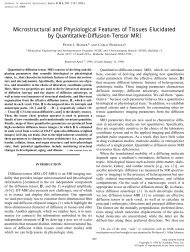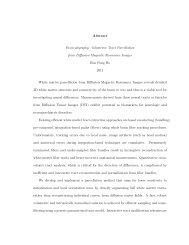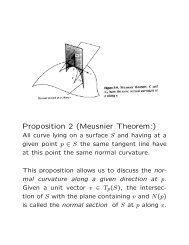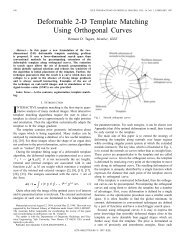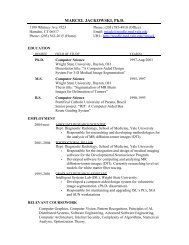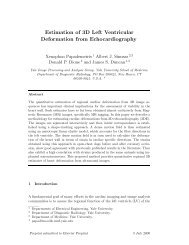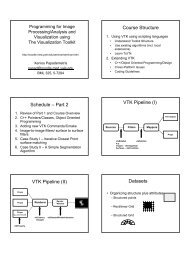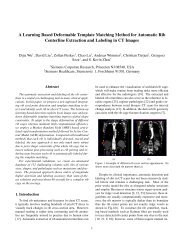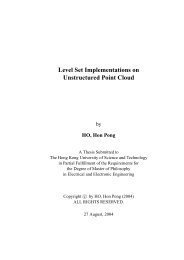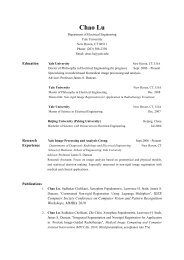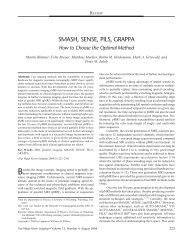Pulsed-field gradient nuclear magnetic resonance as a tool for ...
Pulsed-field gradient nuclear magnetic resonance as a tool for ...
Pulsed-field gradient nuclear magnetic resonance as a tool for ...
You also want an ePaper? Increase the reach of your titles
YUMPU automatically turns print PDFs into web optimized ePapers that Google loves.
206<br />
PRICE<br />
ble if the source of the mismatch is due to eddy<br />
currentgenerated <strong>gradient</strong>s that are not parallel<br />
to the applied <strong>gradient</strong>s Ž 33. or nonconstant mismatch.<br />
We also note that the MASSEY sequence<br />
can be used to alleviate the ph<strong>as</strong>e-twist problem<br />
Ž see Postprocessing . . The ph<strong>as</strong>e-twist problem is<br />
considered in more detail in that section.<br />
Eddy Currents and Perturbation of B 0<br />
The rapid rise of the <strong>gradient</strong> pulses can generate<br />
eddy currents in the surrounding conducting surfaces<br />
around the <strong>gradient</strong> coils Že.g.,<br />
probe housing,<br />
cryostat, radiation shields, etc. . . The severity<br />
of the eddy current problem is thus proportional<br />
to dIdt and the strength of the <strong>gradient</strong>. Although<br />
the generation of eddy currents is greatly<br />
decre<strong>as</strong>ed through the use of shielded <strong>gradient</strong><br />
coils Ž see Gradient Coils . , they can still occur,<br />
especially when using large, rapidly rising and<br />
falling <strong>gradient</strong> pulses. The eddy currents, in turn,<br />
generate additional <strong>magnetic</strong> <strong>field</strong>s and thus have<br />
a close relationship to the problems discussed in<br />
the previous section. It is the decay of the eddy<br />
currents and their <strong>as</strong>sociated <strong>magnetic</strong> <strong>field</strong>s that<br />
determine the minimum delay that must be left<br />
between the end of the <strong>gradient</strong> pulse and the<br />
start of spectral acquisition. Eddy currents can<br />
have the following effects: Ž. a ph<strong>as</strong>e changes in<br />
the observed spectrum and anomalous changes in<br />
the attenuation, Ž b. <strong>gradient</strong>-induced broadening<br />
of the observed spectrum, and Ž. c time-dependent<br />
but spatially invariant B shift effects Ž<br />
0<br />
which appears<br />
<strong>as</strong> ringing in the spectrum . .<br />
We illustrate the effects of eddy currents using<br />
the Stejskal and Tanner sequence <strong>as</strong> an example.<br />
If the eddy current tail from the first <strong>gradient</strong><br />
pulse extends into the second -period, then the<br />
total <strong>field</strong> <strong>gradient</strong> during the second evolution<br />
period will not equal that in the first and the<br />
situation is analogous to the c<strong>as</strong>e of mismatched<br />
pulses see<br />
Amplifier Noise, Earth Loops, and<br />
Nonreproducible Ž Mismatched. Gradient Pulses .<br />
Consequently, even if a spin h<strong>as</strong> not moved in the<br />
direction of the <strong>gradient</strong> during the sequence,<br />
there will be a residual ph<strong>as</strong>e shift. As a result,<br />
the point at which the maximum echo appears<br />
will be shifted and its amplitude will be affected<br />
Ž 34 . . Thus, <strong>as</strong>suming that signal acquisition is<br />
begun <strong>as</strong> usual, at t 2 the eddy currents will<br />
cause additional attenuation unrelated to diffusion,<br />
and perhaps if the eddy currents have not<br />
dissipated be<strong>for</strong>e acquisition begins, ph<strong>as</strong>e shifts<br />
and spectral broadening.<br />
To gain some insight into the effects on the<br />
echo attenuation if the eddy currents generated<br />
by the first <strong>gradient</strong> pulse have not dissipated<br />
be<strong>for</strong>e the application of the pulse, and similarly,<br />
if the disturbances generated by the second<br />
<strong>gradient</strong> pulse have not dissipated prior to the<br />
start of acquisition, <strong>as</strong>suming infinitely f<strong>as</strong>t rise<br />
and but exponential fall Žwith<br />
exponential rate<br />
constant k. of the <strong>gradient</strong> pulses Ž Table 2 . , we<br />
can derive the echo attenuation equation <strong>for</strong> the<br />
Stejskal and Tanner sequence using the same<br />
method <strong>as</strong> be<strong>for</strong>e Žsee<br />
Part 1, The Macroscopic<br />
Approach . . An example program using the symbolic<br />
algebra package Maple Ž 35. is given in the<br />
Appendix Žn.b.,<br />
the new definition of the function<br />
F to allow <strong>for</strong> time-dependent <strong>gradient</strong>s . . The<br />
attenuation equation is given by<br />
Ž 2 2 2 Ž . Ž .4. <br />
Eexp g D 3 f t 10<br />
Table 2 g( t) <strong>for</strong> the Stejskal and Tanner Sequence in Which Eddy Currents Generated<br />
by the First Gradient Pulse Have Not Totally Decayed by the Time of Application of the<br />
Pulse ( A Similar Situation is Depicted in Fig. 5, if te Is Shorter Than the Time Required<br />
<strong>for</strong> the Eddy Current Effects to Dissipate) and Similarly the Eddy Currents from the<br />
Second Gradient Pulse Extending into the Acquisition Period<br />
Ž.<br />
Subinterval of Pulse Sequence g t<br />
0 t t 0<br />
1<br />
t t t g<br />
1 1<br />
t tt ge<br />
1 1<br />
t tt g<br />
1 1<br />
t t2 ge<br />
1<br />
k is the exponential rate constant.<br />
kŽtt .<br />
1<br />
kŽtt .<br />
1



